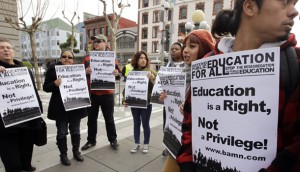Supreme Court to Review State Ban on Affirmative Action
Picture this: A human being is living on a planet populated by a species of plant people which does not need oxygen to breath and which only eats through photosynthesis. The human would demand a special oxygen tank and actual food. Without these accommodations, the human would have little hope of living among these plant people, let alone be successful in their culture. The plant people, in contrast, would wonder why the human is constantly complaining about oxygen and food.
As strange as the “plant people” analogy may sound, proponents of affirmative action use this analogy to explain why racial discrimination is so important to minorities. Of course, most writings on the subject use a fish analogy instead. The point is the same though: minorities do not always have access to wealthy parents, private tutors, study aids, and sometimes, they do not even have a roof over their heads. Academic success is an alien concept in those situations. In 2006 though, Michigan voters passed Proposition Two by 58%, a proposition which completely banned the use of affirmative action in government job hiring, government contracts, and admission into public universities.
 The proposition was challenged by the Coalition to Defense Affirmative Action (CDAA). The Sixth Circuit Court of Appeals overturned the proposition in 2012 in an 8-7 decision. Michigan plans to appeal to the Supreme Court this year. CDAA v. University of Michigan, the name of the case, would be the second affirmative action case heard by the Supreme Court this year, the other one being Fisher v. University of Texas. The cases are both about affirmative action, but they approach the issue from different angles. Fisher is about a white female student being rejected from the University of Texas because of her race. Although the Fisher case is being heard by the Supreme Court first, Fisher is reviewing a previous Supreme Court decision in 2003 about race being one “relevant factor” among many other factors. The CDAA questions whether states can flush the entire concept of affirmative action down the drain.
The proposition was challenged by the Coalition to Defense Affirmative Action (CDAA). The Sixth Circuit Court of Appeals overturned the proposition in 2012 in an 8-7 decision. Michigan plans to appeal to the Supreme Court this year. CDAA v. University of Michigan, the name of the case, would be the second affirmative action case heard by the Supreme Court this year, the other one being Fisher v. University of Texas. The cases are both about affirmative action, but they approach the issue from different angles. Fisher is about a white female student being rejected from the University of Texas because of her race. Although the Fisher case is being heard by the Supreme Court first, Fisher is reviewing a previous Supreme Court decision in 2003 about race being one “relevant factor” among many other factors. The CDAA questions whether states can flush the entire concept of affirmative action down the drain.
The Sixth Circuit overturned a law passed by the people of Michigan because it held that the proposition was a violation of Equal Protection. The argument goes like this: there is unintentional discrimination in the use of GPA and test scores only, since minorities do not always have the same financial resources that other students might have. The intentional discrimination against those who are not part of “minority” groups, i.e. affirmative action, is necessary to address the unintentional discrimination because of past injustice and because diversity is an important state goal in public education.
Diversity is an important state goal because it exposes students to other ideas and lifestyles. One only has to visit the University of California, Berkeley, to understand how a lack of affirmative action impacts campus diversity (the student body in Berkeley is overwhelming Asian). The problem, however, is that diversity should not be forced. Forcing diversity can create racial tensions, because those disadvantaged by affirmative action will resent those who are aided by affirmative action, regardless of actual merit.
The “minorities” would counter that the unintentional discrimination is a form of affirmative action against them, but this raises the question of whether unintentional discrimination is worse or better than intentional discrimination. Given that the goal of anti-discrimination laws and policies is to destroy discrimination thought, saying that one form of discrimination is somehow worse than another form of discrimination is counterproductive.
As mentioned, affirmative action is built on the notion that intentional discrimination is necessary to cure unintentional discrimination. Affirmative action, in addition to being a violation of Equal Protection’s stated goals, also makes another mistake: failure to consider each individual holistically, as a whole and complete individual, rather than as a member of a certain group.
Affirmative action will give an African American or Latino American help regardless of that person’s actual financial resources. Affirmative action will also disadvantage a Caucasian American regardless of how poor and disadvantaged that person may be. The Fisher case gives an excellent example: she is disadvantaged by government affirmative action because she is white, but some would consider her gender a source of discrimination by private parties. Discrimination is messier than either side is willing to consider. Regardless though, affirmative action is a necessary evil at best, not a tool for social good. If affirmative action is a necessary evil, it should be up to each state to determine how to treat that evil.


Comments
Unfortunately by its very nature in making it more advantageous for one section, it will disadvantage another.